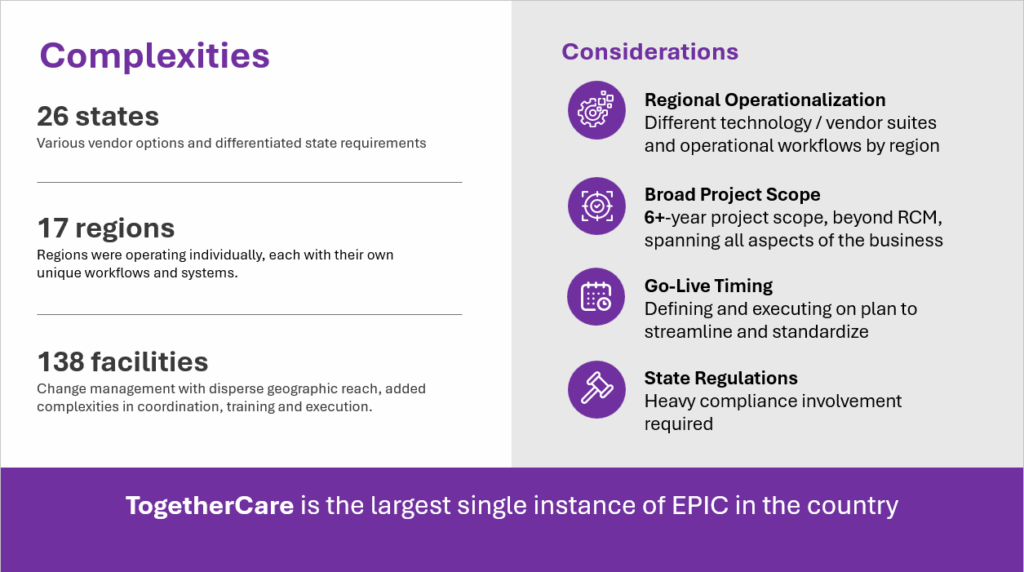By Marina Bigsby, Chief Customer Experience Officer
When Trinity Health embarked on what could become the largest and most complex Epic conversion in U.S. healthcare history, it wasn’t just implementing new software—it was reimagining how a national health system operates.
Spanning almost 100 hospitals across 26 states, Trinity is one of the largest not-for-profit health systems in the country. Its goal was to create a unified patient and provider experience—where systems communicate, billing is consistent, and access to care isn’t blocked by complexity nor cost.
Through this endeavor, which began in 2018 and is still ongoing today, AccessOne has served as a trusted innovation partner, focused on a mission-critical objective: close the affordability gap in healthcare, so people can get the medical care they need.


During the Georgia HFMA Spring Institute, I had the pleasure to help bring this story to life along with Lee Hawkins, Manager, Vendor Management, at Trinity Health. We shared a behind-the-scenes look at how this rollout was executed—and what other health systems can learn from it.
Here are three key lessons for any health system planning a similar journey.
1. Standardization is the Foundation for Transformation
For a system as expansive as Trinity Health, standardization wasn’t just a preference—it was a necessity.
With operations spanning 26 states, 138 facilities, and 17 independently run regions, each using their own technologies, vendors, over a half dozen EMRs, and hundreds of unique workflows, the patient experience was fragmented and inconsistent. In some areas billing systems were more modernized, like while others relied on manual, paper-based processes. This operational patchwork made it difficult to deliver a cohesive patient experience and even harder to enforce compliance with varied state regulations.

Trinity began their conversion effort by consolidating their regional operations. First, from 17 regional health ministries to three primary patient business service centers. And then, post-Covid, to a single Enterprise Patient Financial Service Center. This major operational overhaul paved the way for TogetherCare, Trinity’s standardized instance of Epic, which today stands as the largest single instance of Epic in the country.
To support this transformation, Trinity launched Rapid Decision Groups. These small teams of workflow experts were tasked with defining enterprise workflows in Epic. Once vetted and approved, these workflows became the new standards for the entire system. A dedicated Standards Team ensured those standards were enforced, managing change requests and aligning updates across regions.
2. Vendor Selection Isn’t Just About Cost
Vendor consolidation was critical to Trinity’s success. Enterprise vendor standards weren’t just critical for simplifying operations; they enabled the system to reach alignment on performance, accountability, and shared values.
Every vendor, including AccessOne, was evaluated against enterprise criteria:
- National scalability
- Epic expertise and integration
- Performance metrics and ROI
- Support and responsiveness
- Relationship strength and long-term viability
New vendor management and performance management teams were created. Trinity now had clear apples to apples comparisons across vendors and as Lee put it, “all requests now go through one point of control.”
The system operates in standards at scale with little to no exceptions, which included the data exchange. Once selected, vendors had to conform to a Universal File Spec, a standardized data exchange framework that Trinity has held firm for five years.
Niche vendors with specialized expertise are now available to be scaled nationally. AccessOne is a great example of this. Payment plans have nuances from state to state based on the regional regulation differences.
AccessOne’s Epic extensions allow patients to activate specific payment plan options directly MyChart or Hyperspace, eliminating the need for embarrassing phone calls, delayed decisions, or non-payment altogether. The results of working closely with Trinity’s standardization and vendor teams speak volumes:
- 31% increase in self-service referrals
- 14% reduction in patient finance calls
- 19% year-over-year increase in patient payments to Trinity
Said differently, more patients learn they have payment options they can afford. They can do this on their own, without calling into Trinity’s call center. More patients are selecting these options and actually paying their bills, which results in more payments to Trinity.
This is because AccessOne is so deeply integrated into the EMR system Trinity was moving their entire system into already. As regions were folded into TogetherCare, AccessOne’s automations were available in the tool with virtually no additional development, which made this an easy win, with no extra work.
3. Change Management is a Team Sport
After consolidating 17 independently run regions into one Enterprise Patient Financial Services Center, Trinity built the foundation for system-wide consistency. They introduced governance structures, deep training programs, and vendor readiness sessions that allowed local experts to contribute insights while staying aligned with enterprise goals.
This operational transformation delivered measurable results:
- Doubled operating margin through cost reduction and efficiency gains
- $29B in annual revenue and growing
- Rapid vendor implementation for niche services like AccessOne’s patient financing platform, ERISA recovery, and international collections
- Significant cost savings from consolidation and vendor leverage
- Improved patient experience with a consistent billing journey across all facilities
- Closed process gaps such as unplanned leakage and poor vendor reconciliation
Despite pandemic delays, billing backlogs, and unplanned volume spikes, Trinity adapted quickly, thanks to the groundwork already in place. When COVID hit, the team pivoted from three business offices to one with speed and confidence.
The Bottom Line
Epic conversions aren’t just IT projects; they’re enterprise-wide transformations that demand precision, discipline, and a shared commitment to patient access. Trinity Health’s story shows what’s possible when the right planning and infrastructure meets the right partners.
By focusing on alignment, affordability, and patient empowerment, Trinity not only improved operations but also delivered real results. This wasn’t just an Epic conversion. It was a turning point.



